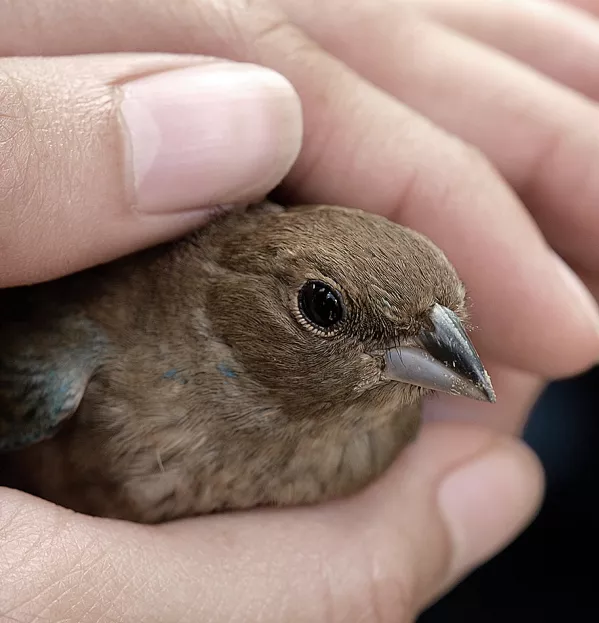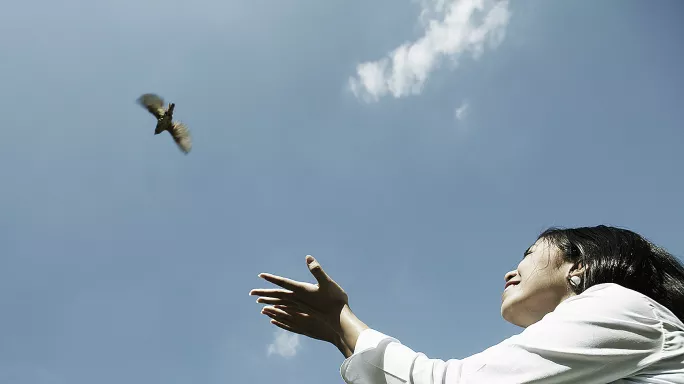
The school trying to do ‘mainstream’ differently

Tommy* is struggling this morning. As usual, his classmates have joined their class checking-in circle to share plans and any personal difficulties. But Tommy doesn’t feel able to take part. Instead, he is standing with his face to the wall.
He’s gently encouraged by his teachers to contribute but it’s clear he’s not ready.
“That’s fine,” they tell him. “We can catch up later.”
Elsewhere, a group of pupils and their teacher are voting on a lesson plan. Later, this group will use the afternoon to act out a zombie film, their faces decorated with painted-on scars.
While these scenes may appear unrelated, they are in fact three examples of how The New School - a non-fee-paying independent school in Croydon, established in 2020 with an initial intake of 46 pupils - is trialling a model that puts wellbeing, mental health and behaviour at the heart of school life. Its aim is to try to reintegrate pupils into school who may have struggled with more traditional mainstream education and ended up being home-schooled.
Positive early evaluations
It may have been open only a short while but this approach has already “demonstrably improved” the lives of the pupils attending - and their families.
This view is not self-promotion from the school but is an evaluation by University of Nottingham (UoN) researchers, commissioned by The New School and seen exclusively by Tes.
“This school has been able to provide an environment for children who had really suffered in previous schools and had been suffering in home-schooling, as well,” says Andrew Townsend, professor of education at the UoN’s School of Education.
There are myriad factors that would make those in education cautious about jumping to any conclusions about this school - it began life during Covid and has only been running a very short time, and it has no long-term pupil data for academic or pastoral measures.
As such, those involved in the school are not making any big claims. What they do want to demonstrate, though, is that other models of mainstream teaching and learning and school culture are possible. And this is something that the government is keen to encourage, after it outlined in its recent SEND and alternative provision (AP) Green Paper that it recognises mainstream education needs to adapt to meet the wider needs of children in the school system.
“Our proposals respond to the need to restore families’ trust and confidence in an inclusive education system with excellent mainstream provision that puts children and young people first,” it said.
The creation of an inclusive mainstream school system is what The New School founder and director Lucy Stephens says she wanted to address in education, after her own time as a teacher showed that what the vast majority of schools offer is not suitable for all pupils.
“I have seen the problems of our profession from the inside,” she writes in an introduction to the University of Nottingham evaluation.
“Teaching to the test, the youth mental health crisis, the damaging and unnecessary exclusion of young people from the system: it does not have to be this way.”
How it works
So, what is the alternative that this school is offering to the mainstream? And what lessons for other mainstream - and potentially non-mainstream settings - might it offer?
Let’s start with some context: admissions at this independent school are non-selective. Places are free to children from Reception to Year 7 and the school is currently funded by unnamed philanthropists.
A Year 8 class is due to start in September as the school expands. It ultimately aims to cater for all primary and secondary years.
Underpinning school life is the concept of “relational practice”. This is an idea from the world of psychotherapy that is geared towards supporting the development of trusting, healthy relationships.
In practical terms, it means children and teachers are on first-name terms, they eat lunch together, and they are encouraged to bond through timetabled processes, such as checking-in and checking-out circles that bookend each day.
These periods, lasting 15 minutes (or longer), are the opportunities for pupils to share any concerns and for teachers to get to know them.
It also means there is a very “democratic” ethos to school life, with almost all decisions made as a collective in order to give children a sense of ownership and a voice within the school.

This is mainly facilitated through “sociocracy circles”, where everyone can share their views and decisions are made collectively.
In practice, there’s one sociocracy circle for each class, which means classes are kept small, in part for this purpose, at fewer than 15 students. In the past, they’ve made decisions to study literacy at a different time, have lessons on different topics and even to arrange water fights.
Learning plans are made and discussed during termly meetings with young people, their parents and teachers. They include three goals that pupils want to work on and get support for, and may be a social, emotional, academic or personal project.
The democratic approach also extends to giving children agency over the times of day where they can conduct self-directed learning - such as making a zombie film, as described earlier.
“The self-directed part of the day is about building up skills around a play-based setting,” says Stephens.
“It is their time to choose what to do. It’s about making a choice and following it through, and if you don’t follow through, that’s OK, too. As you work up the school, it becomes more about setting your goals.”
Solving the behaviour conundrum
The school says this means pupils like Tommy, over time, see school as a place where they have a say in their own education, as Mario Dellow, the school’s pastoral and community accountability lead, explains.
“We take time every day to grow the relationship. We have empathetic, respectful conversations. You don’t just tell them to turn around or that it’s the wrong thing to do,” Dellow tells Tes.
“You’d say: ‘I can see you found that difficult. Is there something I can do?’ Maybe it’s too loud in the room. Maybe they want to sit with a buddy. We discuss it with colleagues. Maybe they just need time.”
This approach to pupils with emotional difficulties and wellbeing needs is also taken into other areas, Dellow explains - perhaps most notably around behaviour management and conflict, where restorative practices are used, rather than punishments.
During one lesson, for instance, two children argued about a class presentation. One ran out of the class, crying, and the other was left in an angry state. Both were supported throughout the day before a “restorative circle” was held.
There, they talked through what happened, shared feelings, made plans to be more patient with each other and agreed to hear the presentation again.
The researchers at UoN discovered this was a model that the children - many of whom had struggled with more usual behaviour models at past schools - found worked well.
“The overall picture is one of improving student behaviour, seen in declining numbers of incidents and a decline in the numbers of students recording incidents,” the evaluation says. “This was ascribed to the restorative justice approach.”

It’s an approach that Professor Alice Jones, director of the Unit for School and Family Studies at Goldsmiths, University of London and editor-in-chief of the British Journal of Educational Psychology, says is key to helping children reintegrate into education.
“Restorative practices can help to demonstrate the utility of perspective-taking, understanding and empathy, and provide useful role-modelling of how to manage conflict,” she says.
“Restorative practice also provides an opportunity for children to think about how they feel, to learn about communicating those feelings and to know that they will be listened to.”
It’s an approach that parents welcome, too. “We know that if things go wrong, it’s going to get worked out,” one parent told the UoN researchers.
Another says the practice had improved their son’s emotional intelligence, while the teachers say it helped develop his self-awareness and empathy.
Such findings showed the school was achieving its aim of establishing “trusting relationships” between pupils and staff, the evaluation says.
Engaging parents to create a community
Engagement with parents is another big part of the school’s ethos. They have their own sociocracy circle through which they can exert influence, a bit like a parent-teacher association.
This group has recently organised a world café event to discuss improving communication at the school and is helping to write the school’s attendance policy.
The short-term data the school has suggests that pupils do engage more in education in this format than the way in which they experienced education previously. For example, two children who had refused to go to previous schools at all attended more than 94 per cent of the time in their first year at The New School.
But there will, of course, be questions about the approach. For example, do the pupils actually use their time productively and do they learn things?
Initially, the school admits there was perhaps too much choice in when and how pupils learned.
“What we found was that decisions were often led by a dominant personality in the group. If that dominant personality wanted to go to art, others would follow. We discussed that and they decided they wanted a timetable,” says Stephens.
This means that the morning timetable is fairly fixed, with literacy and maths in the morning, followed by a specialist subject, such as art, media, ICT or science.
After lunch at communal tables, afternoons are more flexible. Between 12.30pm and 2pm, children sign up for a range of activities, such as a science project, sport, forest school or music.
On Wednesdays, staff run these periods as workshops, according to their own skills. Juggling, Dungeons & Dragons, and capoeira (a Brazillian martial art) have also been featured. The last hour is self-directed, though activities are usually in line with the children’s learning plans.
A learning curve for all involved
Like most schools, The New School’s teachers assess academic attainment in reading, writing and mathematics, with early years foundation stage measures for children in Reception and the national curriculum attainment targets for older children.
It’s achieving good results. At the end of its first year, 60 per cent of children were working at above age-related expectation in reading, according to the evaluation.
Children in Reception had made an average of 7.2 stages of progress per subject. In key stages 1 and 2, they had made 1.85 and 2.57 stages of progress respectively.
In terms of teaching, the system could be challenging for staff: running these types of workshops, and engaging in the more democratic and restorative practices the school focuses on, as well as delivering more ‘traditional’ learning.
Indeed, the evaluation found that while many staff were “very positive” about The New School, many told the researchers that they find the work “extremely challenging” and that it was a “steep learning curve”.
This meant the first year of operations had put everyone under pressure, they told the evaluators. “I feel that I have been playing catch-up and found it very difficult at times,” one teacher said.
“I have just about managed to hold it together,” added another.
Stephens admits that the learning curve remains steep but says this is to be expected in any new setting that is trying to do something different
“A new culture doesn’t get built overnight,” she says. “Working in a relational way does mean you have lots more emotions to hold and deal with, whether they are those of parents, young people or colleagues.”
And what of the behaviour approach?
Alongside the anecdotal insights from the parents noted earlier, the evaluation states that the data shows there has been a good impact in terms of reducing the number of “negative behaviour incidents” that students have been involved in.

In September 2020, there were 29 incidents but in July 2021, there were just four. This decline was disrupted by two peaks of 48 and 42 in November and April respectively, although these peaks occurred during notable staff disruption owing to the pandemic.
It should be noted, however, that attempts to use restorative practice in other mainstream settings have been criticised by some of the teachers in those settings. As restorative practice can be easily misunderstood, more evidence of its use in schools is needed - to which this instance can obviously contribute.
Financial viability for the long term
Perhaps the biggest question, though, is around scale - is this model replicable? Stephens thinks elements of it are.
“You need to prioritise wellbeing and put it on an equal par with academic attainment,” she says. “Why not free up 20 per cent of the day for restorative processes and time for young people to have one-to-ones and group sessions?”
Schools could start by moving from punitive approaches to behaviour to more restorative ones, she adds.
“It’s not always easy to make whole-school changes like that but you can do it in stages.”
Questions remain about whether The New School model can fit into the public funding system, though.
“I do worry about them for their future. The funding context for education is extremely difficult at the moment,” says Townsend.
The UoN evaluation cost-benefit analysis found the benefit of the school to the children, their parents and society outstripped its running costs in its first year by a ratio of £2.40 benefit for every £1 spent.
This is projected to grow to £3.88 for every £1 spent by 2025, when the school plans to have 120 young people and one educator for every six students.
Even with such growth, The New School would still cost more per pupil than its local mainstream secondary schools, but almost half that of alternative, specialist schools, the cost-benefit analysis found.
At present, though, The New School’s future is far from guaranteed, as philanthropic funding will run out next year. Without enough evidence yet of academic attainment, it may struggle to convince council commissioners to pay for pupils to be placed there.
Stephens admits this is a deep concern. “Is there a risk of school closing? Yes,” she says.
“That would just be devastating given that we’ve got as far as we’ve got,” she adds.
She hopes, though, that the early success the evaluation has documented will convince others that the model they have created is one worth funding and pursuing further to see how far the impact can be felt.
“We have got so close to cracking open the education system to allow innovation to come through - it feels like we’re just on the cusp of change.”
*not his real name
Keith Cooper is a freelance journalist
You need a Tes subscription to read this article
Subscribe now to read this article and get other subscriber-only content:
- Unlimited access to all Tes magazine content
- Exclusive subscriber-only stories
- Award-winning email newsletters
- Unlimited access to all Tes magazine content
- Exclusive subscriber-only stories
- Award-winning email newsletters
You need a subscription to read this article
Subscribe now to read this article and get other subscriber-only content, including:
- Unlimited access to all Tes magazine content
- Exclusive subscriber-only stories
- Award-winning email newsletters
- Unlimited access to all Tes magazine content
- Exclusive subscriber-only stories
- Award-winning email newsletters



